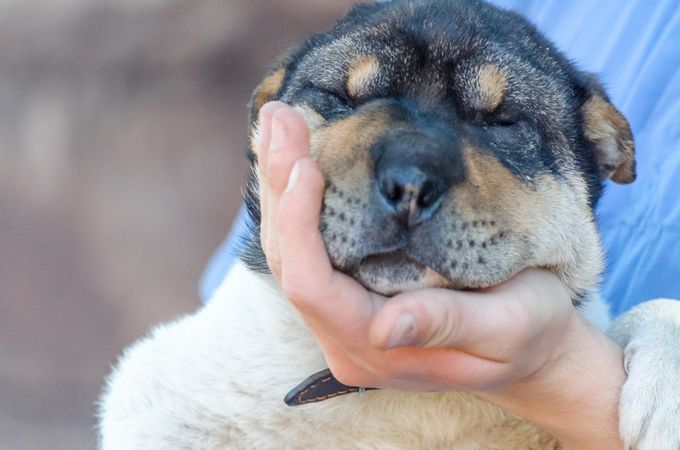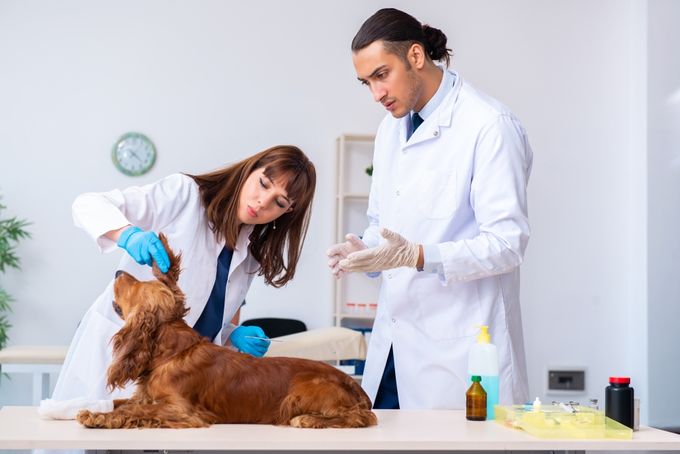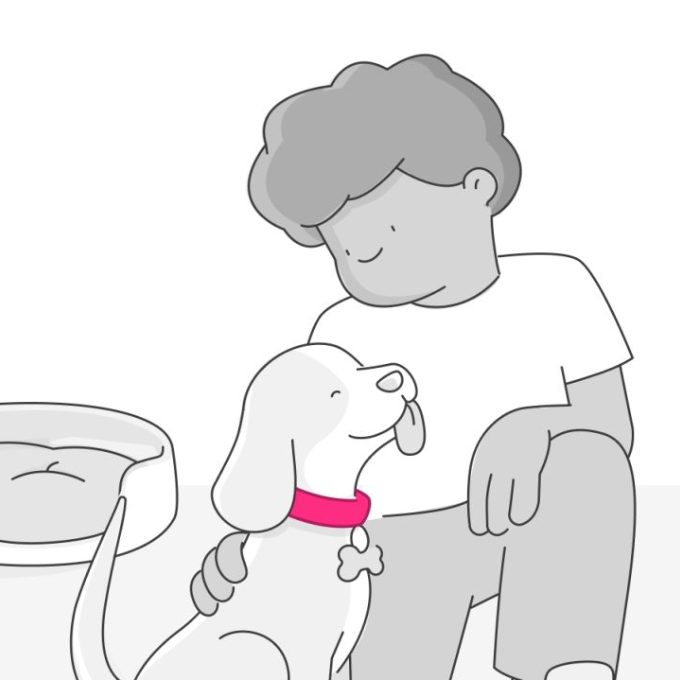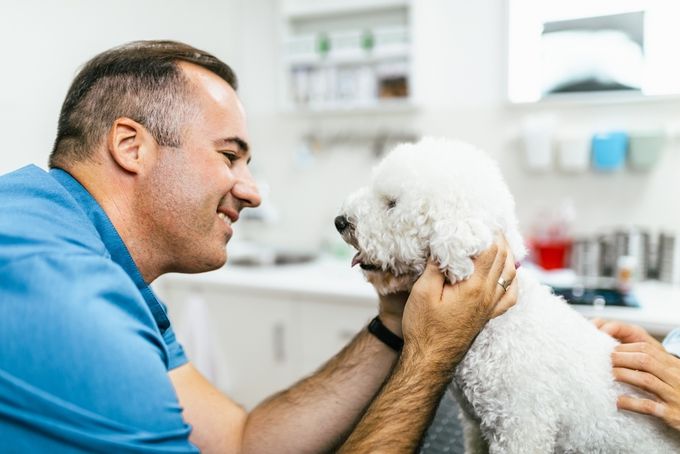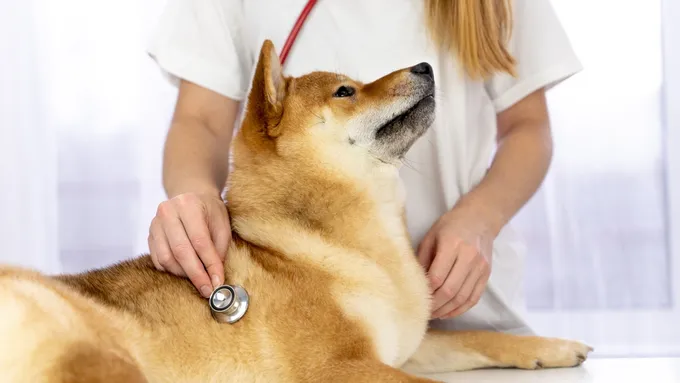10 Common Dog Illnesses: Diagnosis, Treatment & Prevention
Updated May 29, 2023.
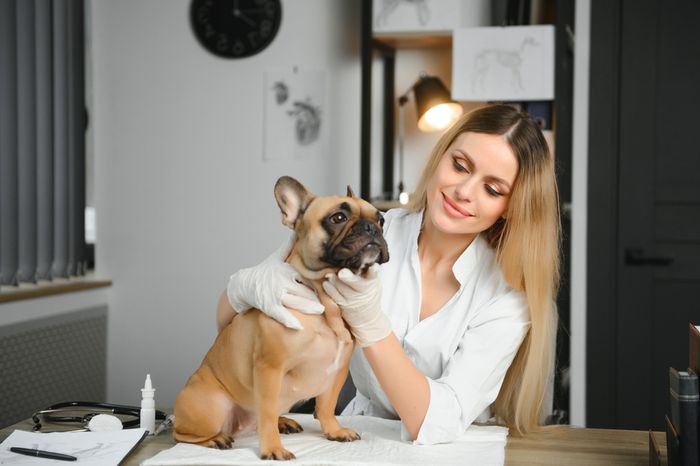
Are you thinking about adopting a furry friend? While it's essential to research a breed's lifestyle, diet, and training needs, there's one aspect that's often overlooked: their health. Knowing the most common health issues that can affect your dog is crucial to keep them healthy and happy. It can also save you trips to the vet.
From dental disease and skin problems to arthritis and obesity, here are some of the most prevalent health issues experienced by most breeds.
10 Common Dog Illnesses
- Dental disease
- Skin problems
- Ear infections
- Arthritis
- Obesity
- Urinary tract infection
- Kennel cough
- Intestinal parasites
- Fungus infection
- Hip dysplasia
Dental Disease
Periodontal disease (periodontitis) is caused by the accumulation of plaque and tartar on the teeth, which triggers inflammation and affects the gums and the bone surrounding canine teeth. If left untreated, it can take up to two years or more off a pet's life.
Symptoms of periodontitis include:
- Loose or missing teeth
- Bleeding or inflamed gums
- Bad breath
- Bloody saliva
- Refusing to eat
Small breed dogs like Chihuahuas, Poodles, and Yorkshire Terriers are more prone to dental disease than other breeds, making dental care even more critical for them.
Diagnosis
To diagnose dental disease in dogs, your veterinarian will typically perform a complete oral examination, including dental X-rays, to evaluate the extent of the damage.
Treatment
Periodontal disease is treatable and can be reversed if detected early. Treatment typically involves scaling the teeth both above and below the gum line to remove plaque and tartar buildup. Your vet may also polish your dog's teeth to help prevent further plaque accumulation.
Prevention
Regular brushing of your dog's teeth, using dental treats, and providing dental diets can all help reduce the buildup of plaque and tartar.
Skin Problems
A dog that's constantly scratching or licking might be experiencing skin issues. The most common skin problems in dogs include:
- Allergies: cause itching, triggered by allergens like grass, pollen, dust mites
- Folliculitis: hair follicle inflammation caused by bacteria or fungus, leads to hair loss, itching, scabs, unusual odor
- Yeast: common in the ear canal, groin, and in between toes, causes a strong smell and pink skin
Breeds like Shar-Peis, English bulldogs, and French bulldogs are more prone to developing skin irritation.
Diagnosis
Vets will perform a physical examination and diagnostic tests if they suspect a skin infection. Depending on symptoms, skin scrapings, skin swabs, and cytology tests might be needed.
Treatment
Allergies might require a change in diet, medicated shampoos, anti-histamines, or flea and tick treatments. Dogs with folliculitis usually need medication or special baths. Yeast infections are treated with antifungal prescription creams and medication such as anti-inflammatory drugs.
Prevention
Skin problems can't always be prevented, but there are things you can do to keep your dog's skin healthier, including:
- Regular bathing
- A nutritious, good-quality diet
- Antiparasitic medications
Ear Infections
Ear infections are very common in dogs, especially in long-eared breeds. Bacteria or dirt, dust, or objects like grass seeds getting stuck inside the ear can all cause ear infections.
Common signs of ear infections include head shaking, discharge, redness or crust inside the ears, and strong odor coming from the ears. Most ear infections can easily be treated with ear drops, but they can also be prevented by regularly cleaning your dog’s ears.
French bulldogs, cocker spaniels, and Shih Tzus are particularly susceptible to ear infections.
Diagnosis
Your veterinarian will check your dog’s ears with an otoscope, looking for redness and heat, pain, and any discharge. It might also be necessary to swab a sample from the ear canal to examine it under the microscope.
Treatment
If there’s debris or an excess of wax inside the ear, your veterinarian will clean your dog's ears using a special medicated cleanser. You might need to continue doing this at home over several days. In severe cases, antifungal ear drops or antibiotics might be needed.
Prevention
The best way to prevent infections is to clean your dog’s ears regularly. Always dry the inside of the ears with a cloth towel or gauze after a bath or swimming.
Arthritis
Arthritis is a condition where the joint cartilage deteriorates, causing inflammation and pain. This can be caused by wear and tear as dogs get older, but it’s often genetic and can also be caused by fractures and other trauma, obesity, and poor nutrition during the development years.
Symptoms of arthritis include stiffness, limping after rest, inactivity and associated weight gain, sleeping more, or avoiding activities your dog used to love. Senior dogs and larger breeds, including Labradors and Golden Retrievers, are more susceptible to arthritis.
Diagnosis
Vets usually start diagnosis with a physical exam, observing gait, and manually checking the joints for pain. X-rays can be useful for finding swelling or bone issues and confirming diagnoses.
Treatment
Anti-inflammatory and pain medications such as nonsteroidal anti-inflammatory drugs (NSAIDs) are often prescribed. Low-impact exercises like swimming and hydrotherapy can also help reduce pain and muscle stiffness.
Prevention
Proper nutrition and a diet rich in omega-3 fatty oils can help the joints. It's also important to work on weight management—being overweight puts pressure on the joints and will worsen your dog's pain and discomfort.
Obesity
Obesity is caused by an accumulation of fat. It's very common in dogs, and it can lead to a number of health problems, including heart and liver disease.
Common signs of obesity include a rounder face, abdominal sagging, excessive panting, and tiredness. Many overweight dogs are reluctant to play or go for walks, even if they used to love it.
Some breeds, including Pugs, Beagles, and Golden Retrievers, are at a higher risk of obesity.
Diagnosis
Dogs are considered overweight when they weigh at least 10% above their ideal body weight. Dogs weighing more than 20% above the healthy weight for their breed are considered obese. Not being able to see or feel your dog's ribs or waistline is another sign of excess weight.
Treatment
If your dog is overweight, try:
- Keeping your dog active: add more walks, take your dog swimming
- Limiting treats
- Switching to a lower-fat, lower-calorie diet customized to your dog's needs (discuss with your vet first!)
Prevention
Talk to your veterinarian about portion size. Don’t overfeed them with treats, and be consistent with mealtimes, so your dog is never overly hungry.
Urinary Tract Infection
UTIs are caused by bacteria such as E.coli, but can also be the result of a fungi infection. Dogs with a UTI will show very specific symptoms, including straining to urinate, pain, blood in the urine, licking of the genitals, and dripping urine.
Any dog can get a UTI, but Shih Tzus, Yorkshire Terriers, and Bichon Frises are also predisposed to urinary tract stones. Female dogs are more likely than males to develop UTIs.
Diagnosis
If you suspect your dog might have a UTI, call your veterinarian. A physical examination and blood tests are important to rule out other underlying conditions, such as kidney disease or bladder cancer. Your vet will then collect a urine sample and send it to the lab to confirm the infection and to choose the best antibiotic to fight it.
Treatment
UTIs need to be treated with antibiotics for 1–2 weeks. The vet might then repeat the urine culture test to see if longer treatment is needed.
Prevention
You can lower the risk of UTIs in dogs in the following ways:
- Regular bathing and grooming (including cutting excess hair around the urinary opening)
- Taking your dog out to urinate several times a day
- A healthy, well-balanced diet
Do Pet Insurance The Lemonade Way
Lemonade Pet Insurance is a digital platform that eliminates the need for tedious paperwork and ensures that your claims are settled in record time.
Lemonade Pet Insurance includes the following benefits:
- Get covered in seconds
- Claims are approved in minutes
- Receive multiple discounts
- Covers tests, vaccines, and essential care
- Made for your puppies and kittens too
Kennel Cough
Kennel cough (or infectious bronchitis) is a highly contagious disease caused by bacteria, viruses, or a combination of both. It causes a persistent, hacking cough, a runny nose, retching, and eye discharge.
Dogs often get kennel cough by being around other sick dogs, sharing toys, or eating and drinking from the same bowl as a sick dog. Without treatment, dogs with kennel cough can experience a loss of appetite, develop a fever, and suffer more serious breathing issues.
Diagnosis
There’s no specific test for kennel cough, so vets will often diagnose based on symptoms. Always tell your veterinarian if your dog has recently spent time at a kennel or doggie daycare, where he could have been exposed to infectious bronchitis.
Treatment
The most common recommendation is rest (light activity, no excitement) for 1–2 weeks. Antibiotics and cough medicine can be prescribed in serious cases to make your dog more comfortable as he heals.
Prevention
Dogs that spend time at doggie daycare or kennels should get vaccinated against kennel cough. The vaccine is administered in the form of a nasal spray once a year.
Intestinal Parasites
The four most common types of intestinal worms in dogs include:
- Roundworms
- Tapeworms
- Hookworms
- Whipworms
Dogs get worms by ingesting an infected rodent (or another animal) or picking up worms or eggs in contaminated food or water. Worms are often visible in your dog’s vomit or stool—they might look like broken pieces of rice or a short piece of string.
Common symptoms of a worm infestation include:
- Diarrhea
- Vomiting
- Pot-bellied appearance (especially obvious in puppies)
- Weight loss
- Lethargy and weakness
- "Scooting" on the ground
Diagnosis
Since not all worms are visible or excreted in your dog’s feces, your veterinarian will ask for a stool sample so he can look at it under the microscope. This will also help confirm which worms are present so your vet can choose the best treatment.
Treatment
Your vet will prescribe medication to kill the worms and eggs. Repeated treatment might be necessary for serious infestations, but most dogs recover quickly and well.
Prevention
Regular worming treatment is essential to prevent parasites. Always remove feces quickly from your garden or places where your dog might have access to them.
Fungus Infection
Dogs can get a fungal infection through contact with sick animals. Dogs with weak immune systems can also experience an overgrowth of fungi naturally present in the body. Common symptoms of a fungal infection include flaky skin, intense itchiness, hair loss, lethargy, and loss of appetite.
Diagnosis
Your veterinarian will start by checking the skin for obvious symptoms of an infection. To confirm, a fungal culture skin test should be performed. This can be done via skin scraping, a swab sample, or a biopsy, depending on the location and the size of the area affected.
Treatment
Medicated shampoos or ear ointments can help fight the infection. Sometimes antibiotics are also needed.
Prevention
Avoid high-risk environments and use medicated baths and dips if your dog has been in contact with sick dogs. Vacuum and disinfect your home to stop the infection from spreading.
Hip Dysplasia
Hip dysplasia is caused by a loosening or deformation of the hip joint that occurs as your dog grows (usually between 6-12 months of age). Over time, it can lead to arthritis, muscle atrophy, and limited mobility. Although it can happen to any dog, larger breeds are more prone to it.
Common signs of hip dysplasia include pain and weakness in the hip and back legs area, a decreased range of motion, and a reluctance to walk or jump.
Diagnosis
Vets can often diagnose based on symptoms and observation. The only way to confirm hip dysplasia is with a set of X-rays of the hip joint taken under anesthesia.
Treatment
Weight reduction, exercise restriction, and physical therapy can ease the stress on joints and reduce pain. Hip replacement surgery is sometimes possible in advanced cases.
Prevention
Hip dysplasia is hereditary and can’t always be prevented. A healthy diet and nutritional supplements can help reduce symptoms and ensure the skeletal system develops properly.
The Benefits of Pet Insurance for Your Dog
In addition to learning about how to feed and care for your dog properly, consider getting your dog insured. Pet insurance can help you minimize vet expenses if your pet gets sick or injured.



